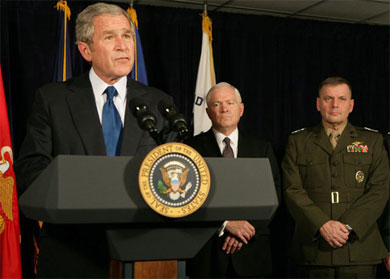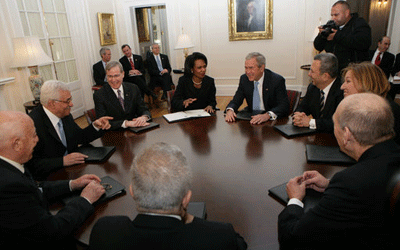Strategic Culture Foundation
online magazine
07.12.2007
Leonid IVASHOV
What We Should Expect From Hillary Clinton
Hillary Clinton, the wife of the former US President Bill Clinton and a 2008 presidential race favorite recently unveiled her international politics agenda in a paper in Foreign Affairs. (Hillary Rodham Clinton. Security and Opportunity for the Twenty-first Century. Foreign Affairs, November/December, 2007). The publication provides a fairly critical account of a number of aspects of G. Bush’s presidency.
A wind of change in the US foreign politics? Hardly so. The analysis of the criticism directed at the Republican Administration by H. Clinton and of the plans drawn in her paper shows that no radical changes in Washington’s global strategy can be expected in the foreseeable future.
What H. Clinton criticizes G. Bush and his administration for is by no means their tendency towards global dominance or the underlying strategy formulated by the US Congress in 2005 as «gaining an unobstructed access to the world’s key regions, strategic communications, and global resources» (in other words, gaining control over all of the above).
The US quest for global hegemony has persisted for over a century. Only methods do evolve. Whereas Rear Admiral A. Mahan, a prominent late XIX-century US geostrategist, emphasized the importance of the sea power, military activity, and the strategy of strangling Eurasian continental powers in the «anaconda coils», US President W. Wilson espoused the idea of a «peaceful» partition of rival countries and their subsequent occupation. US President W. Taft suggested using the US dollar as the instrument of subduing other nations. The common elements of those strategies were both the idea of the US global dominance and the notion that Russia had to be chosen as the prime target of such efforts.
H. Clinton’s approaches to international issues are not essentially new. This is no surprise – her foreign politics advisors – M. Albright and S. Talbott – are the authors of the US aggression against Serbs.
Continuity is an indispensable trait of the US foreign politics. B. Clinton’s presidency was marked by a powerful NATO and US attack on Yugoslavia. The course taken by his successor G. Bush envisions «a peaceful resolution» of the Balkan crisis. The partition of the former Yugoslavia continues in the form of the separation of first the Montenegro, and, as the next step, Kosovo from Serbia.
If elected, H. Clinton intends to do the same in Iraq. Currently, she is leveling criticism at G. Bush for the US military involvement in the country, but this should not be taken too seriously. Similarly, G. Bush criticized B. Clinton for Yugoslavia while being the presidential contender. This political ping-pong is a game routinely played by the US Republicans and Democrats. No doubt, in case H. Clinton makes it to the White House in 2008, she will bring to the completion the ongoing process of partitioning Iraq into three minor pseudo-independent states. Such is the general logic of the US global strategy implemented regardless of who is the current President.
H. Clinton stresses that leadership is «based on respect more than fear», while also explaining that «there is a time for force and a time for diplomacy». In other words, initially the US interests must be promoted with the help of civilian means (as it was in the case of S. Milosevic), and later comes the time to resort to force (as in the cases of Serbs, Iraqis, etc).
H. Clinton’s loud phrases concerning the peace plan for Iraq and the withdrawal of the US troops from the country are immediately offset by the statement that «...we will have to replenish American power by getting out of Iraq, rebuilding our military, and developing a much broader arsenal of tools in the fight against terrorism». The reasoning is the same as that of G. Bush. Consequently, we should expect to see point strikes against Al-Qaeda (a truly universal pretext) and some other terrorist groups, whose names are not hard to invent no matter what country is being dealt with. Consequently, US military bases will remain in the Iraqi Kurdistan even after their withdrawal from the southern and central parts of Iraq. By the way, G. Bush is already creating the infrastructure for deploying the US troops in Kurdistan, perhaps as a gift to give his successor.
One can discern only minor divergences in H. Clinton’s and G. Bush’s approaches to building up the US military might.
For example: «... I will work to expand and modernize the military ... the Bush Administration has undermined this goal by focusing obsessively on expensive and unproven missile defense technology... ». Seeking any kind of international balance is not even considered – the plan is to pursue the absolute US military and technological superiority. The problem with G. Bush as seen by H. Clinton is solely that he has not done a sufficiently good job to that end. By the way, just recently, the predominantly Democratic US Congress allocated some extra $100 mln to create a space shuttle with a strike capability, which is going to hit targets from the space orbit at distances over 16,500 km.
H. Clinton also pledges to raise the efficiency of the US intelligence community, to turn it into «a clandestine service that is out on the street, not sitting behind desks». Obviously, this refers to a focus on the operations abroad. H. Clinton clearly intends to use stick and carrot in dealing with Iran’s nuclear program. Should Tehran refuse to accept the US terms, then no type of response will be ruled out. In this respect, there are no differences with the policy of the current Administration whatsoever.
Finally, what’s new in H. Clinton’s approach to the Russian-US relations? Her opinion is that Russia is among the countries which «... are not adversaries but that are challenging the United States on many fronts». The contentious issues include Kosovo, the alleged use of fuel supplies as the political leverage against Russia’s CIS neighbors, and Russia’s trying the patience of the US and Europe in what concerns nonproliferation and arms control (the latter is a clear reference to Russia’s freezing its participation in the Treaty on Conventional Armed Forces in Europe (CFE), which was defunct anyhow).
And, of course, Mrs. Clinton criticizes V. Putin who has «suppressed many of the freedoms won after the fall of communism». She finds it inconceivable that Russia and the US might adhere to different interpretations of democracy and that Russia will never opt for the «US-style» democracy. Nevertheless, she is convinced that Russia should be engaged in resolving the international problems important to the US. Thus, the role reserved for Russia is that of an assistant (Moscow’s having a strategy of its own must be something impossible to imagine).
Speaking of H. Clinton’s foreign relations agenda, one concludes that the US goals in international politics have not changed over decades. Therefore, it does not make a great difference who exactly moves into the White House.




![[chart]](http://s.wsj.net/public/resources/images/P1-AJ704B_Ethan_20071127204855.gif)
![[Bob Dinneen]](http://s.wsj.net/public/resources/images/HC-GL065_Dinnee_20071127225053.jpg)
![[chart]](http://s.wsj.net/public/resources/images/EV-AA003C_ETHAN_20071026153549.gif)



![[Most Recent Quotes from www.kitco.com]](http://www.kitconet.com/charts/metals/gold/t24_au_en_eukg_2.gif)
